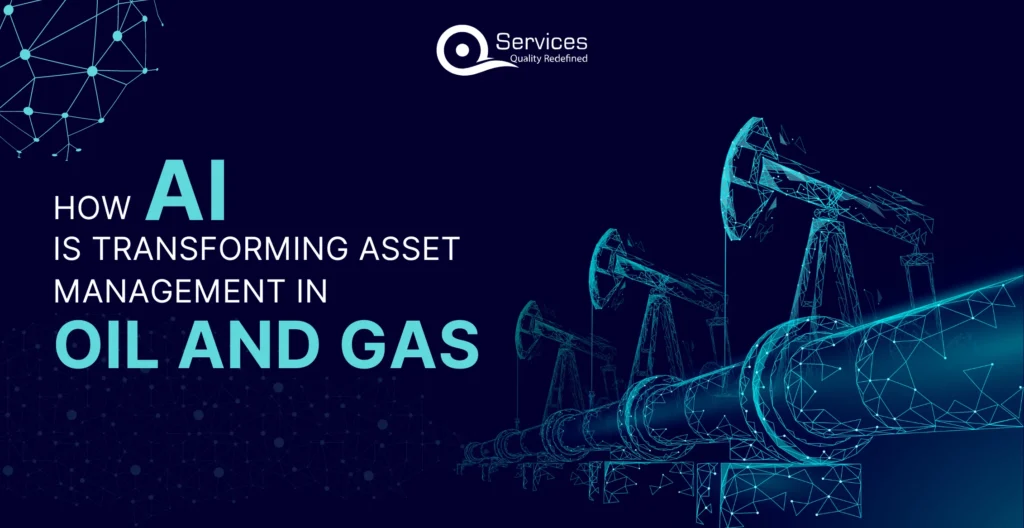
Home » How AI is Transforming Asset Management in Oil and Gas ?

The oil and gas industry, known for its vast and diverse asset portfolio, faces significant challenges in managing its resources efficiently. Effective asset management is crucial to maintaining operational integrity, ensuring safety, and maximizing profitability in this complex sector. With assets spread across remote and often harsh environments, the industry must deal with extensive logistics, stringent regulatory compliance, and the high costs associated with equipment maintenance and downtime.
As the demand for energy continues to grow and the pressure to decarbonize intensifies, the need for innovative solutions in asset management becomes more critical. Advanced technologies, particularly artificial intelligence (AI), are emerging as key enablers in transforming asset management practices. By utilizing AI, oil and gas companies can enhance predictive maintenance, optimize asset utilization, and drive sustainable operations, thereby addressing the twin challenges of improving efficiency and meeting environmental goals. In this blog we explore how ai-based assets management systems impact the oil and gas industry.
Efficient asset management is very important in oil and gas operations for several reasons:
Optimizing Operations: Good asset management helps run operations smoothly, reduces downtime, and boosts productivity. It ensures all assets work well, and any problems are quickly found and fixed.
Cost Savings: By keeping up with regular maintenance and timely repairs, companies can avoid expensive breakdowns and shutdowns. This leads to significant cost savings over time.
Risk Management: Asset management helps manage risks related to equipment failures, safety hazards, and environmental impacts. It aids in taking preventive measures and reducing risks.
Regulatory Compliance: The oil and gas industry has many regulations. Effective asset management helps in staying compliant with these rules, avoiding fines and legal issues.
Longevity of Assets: Regular maintenance and efficient management can extend the life of assets, delaying the need for replacements and saving costs.
Data-Driven Decisions: Asset management systems provide valuable data on the performance and condition of assets. This data can be used to make informed decisions about asset use, maintenance schedules, and investments in new assets.
Get free Consultation and let us know your project idea to turn into an amazing digital product.
The oil and gas industry often operates in hard-to-reach and tough environments, which makes asset management difficult. These remote locations, like deserts, offshore platforms, or deep forests, are hard to access, complicating regular maintenance and inspections. The harsh conditions, such as extreme temperatures and saltwater, can quickly wear out equipment, requiring sturdy and reliable machinery.
Additionally, the industry uses a wide variety of assets, including drilling rigs, transport vehicles, pipelines, and refineries, each with unique maintenance needs and challenges. For example, drilling equipment needs regular lubrication, while pipelines require constant leak checks. Managing these diverse assets effectively requires advanced systems, detailed maintenance schedules, specialized tools, and skilled workers who can handle different types of equipment.
Keeping track of assets and managing inventory are crucial but challenging in oil and gas inventory management due to the industry’s large scale and spread-out locations. Assets located across vast areas, including offshore and remote sites, need accurate tracking to prevent losses and ensure smooth operations.
In oil and gas asset tracking, typical issues include incorrect data, misplaced assets, and inefficiencies in inventory management. Errors in data can lead to poor decisions, causing delays and increased costs. Misplaced assets result in costly replacements and operational disruptions, while subpar inventory management may lead to overstocking or shortages of critical items. Efficient asset tracking systems employing GPS, RFID tags, and IoT sensors offer real-time visibility of assets, minimize losses, and enhance inventory management effectiveness.
Asset management aims to keep assets running well and reduce downtime. However, this is tough due to equipment wear and unexpected failures. These problems disrupt production and can be dangerous.
Predictive maintenance, using data analytics and AI, can help by spotting potential issues before they cause failures. This proactive approach allows for scheduled maintenance during planned downtimes, cutting unexpected outages and extending asset life. Regular training for workers on the latest maintenance techniques also helps improve asset performance and reliability
Maintaining and operating assets in the oil and gas industry is costly. Expenses include routine maintenance, repairs, parts replacement, and sometimes replacing entire assets. Downtime costs, such as lost production and safety risks, also add to the expense.
To reduce these costs while maintaining safety and efficiency, companies can use predictive and preventive maintenance strategies to prevent unexpected breakdowns. Investing in high-quality, durable equipment can decrease the need for frequent repairs and replacements. Advanced asset management systems can identify cost-saving opportunities and optimize resource use. While these strategies require an initial investment, they lead to long-term cost savings and improved asset performance.
Overcoming these challenges can significantly improve asset management in the oil and gas industry, resulting in enhanced efficiency, cost savings, and sustainability.
Artificial Intelligence (AI) is a technology that enables computers and machines to emulate human intelligence and solve complex problems. It includes various domains such as machine learning, natural language processing (NLP), and computer vision.
Machine learning:
Machine Learning (ML) is a branch of artificial intelligence designed to give machines the ability to learn from data and enhance their own performance. This includes techniques like reinforcement learning, in which machines learn by maximizing rewards through trial and error, supervised learning, in which they learn from labeled data, and unsupervised learning, in which they find patterns in unlabeled data.
Natural Language Processing (NLP): NLP is centered on making computers understand and interpret human language. By leveraging NLP, machines can comprehend written or spoken text, facilitating tasks like language translation, keyword extraction, and topic classification. This enhances the natural interaction between humans and machines.
Computer Vision: Computer vision is a field of AI that empowers computers to analyze and understand visual information from the world. In sectors like oil and gas, computer vision is employed for inspecting and maintaining infrastructure, detecting anomalies, and ensuring safety. By processing images and videos, machines can conduct detailed and accurate visual inspections, enhancing reliability and reducing risks.
Microsoft Copilot Studio is a powerful platform for creating, testing, and deploying AI-driven copilots. These customizable AI tools support specific business processes and integrate seamlessly with Microsoft Teams and Microsoft 365 applications. In the oil and gas industry, Copilot Studio enhances asset management by automating and optimizing key processes.
Customization and Deployment: Copilot Studio enables businesses to tailor AI copilots to their unique needs, streamlining inventory management, predictive maintenance, and other critical operations for improved efficiency.
Seamless Integration: These AI copilots integrate with Microsoft Teams and other Microsoft 365 applications, providing a cohesive user experience and enhancing workflow efficiency.
Process Automation: AI copilots automate routine tasks, reducing manual effort and minimizing errors. For instance, they can track inventory, reorder supplies, and generate reports automatically.
Predictive Maintenance: AI systems monitor equipment health, predict failures, and schedule maintenance proactively, preventing costly downtime and extending asset lifespan.
Data-Driven Insights: Copilot Studio leverages data analysis for informed decision-making, helping managers optimize asset utilization and operational improvement.
Enhanced Safety and Compliance: AI copilots monitor compliance with safety standards and regulations, reducing risks and ensuring adherence to guidelines.
Microsoft Copilot Studio is a robust solution for AI-driven oil and gas asset management, automating processes, enhancing maintenance, and facilitating data-driven decisions to optimize operations and ensure safety.
AI in asset management offers numerous benefits in improving asset tracking, inventory management, and performance optimization in the oil and gas industry:
Efficient Inventory Control: AI has revolutionized inventory management by transforming how warehouses and logistics operations maintain their stock. The powerful capabilities of AI enable these operations to optimize inventory levels, leading to improved operational efficiency.
Real-time Monitoring: AI, in conjunction with advanced technologies like the Internet of Things (IoT), allows businesses to monitor their inventory in real time. This real-time visibility ensures that companies can respond swiftly to changes and maintain optimal inventory levels.
Optimized Demand Forecasting: AI leverages a multitude of data sources, including historical sales data, market trends, and economic indicators, to forecast future demand accurately. This predictive capability helps businesses anticipate the need for specific products, reducing the risk of overstocking or stockouts.
Smart Replenishment: AI facilitates timely updates of stock levels, ensuring that inventory is replenished as needed. This smart replenishment process results in cost savings, enhanced operational efficiency, and better decision-making for the business.
AI has numerous valuable applications in asset management within the oil and gas industry:
Predictive Maintenance: AI continuously monitors equipment to detect potential issues before they cause unexpected failures. This proactive maintenance strategy reduces downtime and lowers repair costs by addressing problems early.
Advanced Data Analysis: AI processes and analyzes vast amounts of data more quickly and accurately than human capabilities. This enables more informed decision-making and enhances overall operational efficiency.
Safety Enhancement: AI improves safety by identifying potential hazards and issuing early warnings. This capability helps mitigate risks and maintain a safer working environment.
Environmental Protection: AI plays a crucial role in minimizing environmental impacts by detecting and preventing leaks or emissions. This proactive approach supports sustainability and environmental conservation efforts.
Accurate Demand Forecasting: AI models analyze extensive historical data, market trends, geopolitical events, and social media sentiment to uncover complex patterns and correlations. This sophisticated analysis allows for precise demand forecasting, aiding in better resource planning and allocation.
Real-time Monitoring: By leveraging sensors and IoT devices, AI enables real-time tracking of inventory movement and condition. This continuous monitoring ensures efficient inventory management and swift resolution of any issues.

AI is fundamentally transforming oil and gas industry asset management by driving significant improvements in efficiency, safety, and sustainability. By integrating AI, companies can optimize their operations, make data-driven decisions, and proactively manage their assets. This technological advancement not only enhances the industry’s performance but also supports environmental protection and ensures a safer working environment. AI’s impact is reshaping the future of asset management for oil and gas, leading to more reliable, efficient, and sustainable operations.

Our Articles are a precise collection of research and work done throughout our projects as well as our expert Foresight for the upcoming Changes in the IT Industry. We are a premier software and mobile application development firm, catering specifically to small and medium-sized businesses (SMBs). As a Microsoft Certified company, we offer a suite of services encompassing Software and Mobile Application Development, Microsoft Azure, Dynamics 365 CRM, and Microsoft PowerAutomate. Our team, comprising 90 skilled professionals, is dedicated to driving digital and app innovation, ensuring our clients receive top-tier, tailor-made solutions that align with their unique business needs.

Loan processing is a core function of financial institutions. When customers apply for loans, they’re often in urgent need and expect quick decisions. However, banks face delays due to due to manual document verification, credit risk assessments, and compliance checks.

To move towards future-ready banking, automation is not just good to have—it’s necessary. In this blog, we’ll explore why the banking automation industry is key to modern finance and why banks must act now to stay competitive and compliant.

Traditional fraud detection methods often fall short in detecting today’s fraud intelligence. They rely on pre-set rules and struggle a lot. This is where the role of machine learning steps in. Using AI-powered fraud detection in banking is a smart way to deal with cyber threats.
AI is transforming asset management in the oil and gas industry by enhancing efficiency, safety, and sustainability through predictive maintenance, real-time monitoring, and rapid data analysis. Platforms like Copilot Studio streamline AI implementation, making it more effective and accessible overall.
Generative AI, a subset of AI, autonomously generates content from existing data in the oil and gas industry. It enhances efficiency, reduces costs, and improves safety by optimizing drilling, predicting maintenance, and refining reservoir simulations. Applications include reservoir modeling, drilling efficiency, production forecasting, and supply chain optimization, driving industry-wide improvements in performance, productivity, profitability, and sustainability.
AI’s future in the energy sector is promising and transformative. It will optimize energy production, distribution, and consumption, enhance grid management and renewable energy integration, and improve demand forecasting and asset management. AI is set to revolutionize the energy sector by driving operational excellence, cost savings, and international energy security.
AI transforms downstream operations in oil and gas, optimizing refining processes for higher output and reduced waste. It revolutionizes refinery operations, supply chains, safety, risk management, marketing, and environmental impact assessments. AI-driven solutions improve efficiency, safety, resource allocation, and customer satisfaction, enhancing overall productivity in the industry.
AI enables real-time monitoring through IoT sensors and data analytics, providing immediate insights into equipment performance, safety parameters, and operational conditions.
INDIA : F-190, Phase 8B, Industrial Area, Sector 74,
Mohali, India
CANADA : 55 Village Center Place, Suite 307 Bldg 4287, Mississauga ON L4Z 1V9, Canada
USA :2598 E Sunrise Blvd, Fort Lauderdale,FL 33304,
United States

Founder and CEO

Chief Sales Officer
